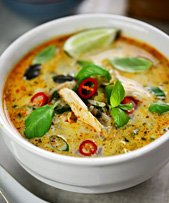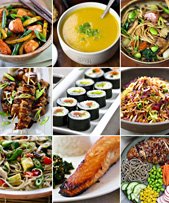Can-venience cooking

I get great pleasure from keeping our pantry shelves stocked with packages and containers of dry goods, filled with bottles and jars of oils, sauces and seasonings, and stacked high with cans of food. It gives me a sense of power (and peace of mind) to know that, within arm’s reach, I have the basic ingredients to create delicious and varied meals at a moment’s notice without having to leave the house.
I find canned foods particularly useful because they’re not only easy to stock up on and have a long shelf life, they’re also affordable and tasty. Canned ingredients are especially convenient when you’re busy, and can save you a lot of time and effort in the kitchen. Preparation is minimal because the food has been pre-cooked in the can so only requires heating up (or not if you prefer to eat the contents cold straight from the can). Also, the variety and quality of canned foods available these days is amazing. Supermarket shelves are packed with a huge range of canned goods from around the globe including tomatoes from Italy, Kalamata olives from Greece, coconut milk from Thailand, sardines from Spain, and bamboo shoots from China, that allow you to experiment with different ethnic cuisines.
These are the canned foods we always have on stand-by in our pantry and some ideas on how we use them:
Canned fish and seafood: With their high protein content, canned tuna, salmon, sardines, mackerel, anchovies, baby shrimp, crab meat, smoked mussels and oysters provide nutritious meals and snacks. Toss a can of tuna or some anchovies into a simple tomato-based pasta sauce; stir salmon or baby shrimp into a risotto, add mackerel to a kedgeree (an Indian rice dish), mash sardines with lemon juice and capers and spread on lightly buttered whole grain toast; use tuna or salmon as a filling for sandwiches and wraps, toss into salads, or make into fish cakes; top a pizza with smoked mussels or oysters or enjoy them by themselves as a simple snack.
Canned beans and lentils: The best thing about legumes from a can is that there’s no soaking required — just drain and rinse before use. Combine a can of chickpeas with tahini, lemon juice and garlic in a food processor to make hummus for dipping or spreading on wraps, or add whole to Indian curries or Mediterranean stews; use canned lentils to make dhal or vegetarian Bolognese sauce or scatter them into salads; and add white beans to pasta dishes or soups like Minestrone or Soupe au Pistou.
Canned vegetables: When fresh vegetables are out of season the canned varieties are indispensable. Canned tomatoes (whole, chopped and puréed) make an excellent base for pasta sauce, soups, stews and curries; canned Asian vegetables including water chestnuts, bamboo shoots, and straw mushrooms make quick and easy additions to stir-fries, braises and noodle dishes; canned corn (kernels, baby corn, and creamed), artichoke hearts and asparagus are acceptable alternatives to fresh and work well in dishes like frittatas, pizzas, pastas and risottos; and canned beets are great on sandwiches and salad plates.
Canned fruit: A lot of fruits, especially short-season varieties which aren’t available year round and the more exotic fruits grown abroad, are handy canned. Apricots, peaches, plums, pears, cherries, lychees, mandarins and papaya are ideal served with gelato, sorbet or yogurt and can also be mixed with fresh fruit to bulk out fruit salads. Canned pineapple is also tasty in Chinese sweet-and-sour dishes, Thai curries and, albeit unauthentic, as a pizza topping.
Miscellaneous: Canned coconut milk can be used in a wide range of Indian and Southeast Asian dishes like curries, laksa and peanut sauce. We buy fabulous canned Kalamata olives from Greece, and anchovy or pimento-stuffed green olives from Spain which are divine in pasta dishes, stews, salads, risottos, sandwiches, on pizza, blended into tapenade, or simply eaten by themselves.







